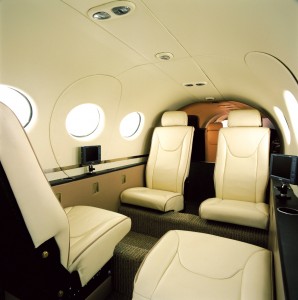By S. Clayton Moore

Left: Rick Adam, founder of Adam Aircraft, relaxes in one of the company’s Centennial Airport hangars with the A700 AdamJet.
Adam Aircraft is getting ready for the future. The celebrated Colorado-based aircraft company is ramping up its production capabilities, increasing its gifted staff of engineers and mechanics, and celebrating a highly productive visit to the famous Fun n’ Sun Fly-In in Florida in April.
It’s hard to name another airplane company that has made as many leaps and bounds this year as Rick Adam’s eponymous corporation, which is quickly expanding its facilities in both Colorado and Utah. Adam is already delivering its prop-driven A500 centerline twin to customers and is well on its way to full certification on the A700 AdamJet. There are more surprises in store as well, including a third airplane from Adam Aircraft.
Rick Adam took the time recently to sit down with Airport Journals to discuss the past, present and future of one of the aviation industry’s most innovative companies.
“It feels great right now,” Adam said as he walked through the assembly facility at Centennial Airport, greeting employees at the 24-7 operation. “We’re finally getting airplanes to customers and they really like them, so it’s great to be up and in production.”
Adam, whose diverse background includes stints at the Kennedy Space Center, Vandenberg Air Force Base and Goldman Sachs, was once known best for forming New Era of Networks, an integration software company that was sold to Sybase for nearly one-half billion dollars in 2001.
But it’s likely that Adam’s true legacy will be the aviation company that bears his name. He founded the company in 1998, trusting industry icon Burt Rutan of Scaled Composites to engineer a prototype of an innovative airplane that combined stock components with a unique carbon-fiber body.
That initial design led to the development of the A500, a $1.2 million, six-seat, pressurized business twin. Powered by two Teledyne Continental TSIO-550-E 350-hp engines, it has a maximum cruise speed of 230 knots, a range of nearly 1,500 nautical miles and a maximum operating altitude of 25,000 feet.
Its cousin, the A700 AdamJet at $2.2 million, is distinctly similar in style but more robust in capabilities. The A700 is a turbofan-powered, six-seat aircraft, driven by two Williams International FJ33 engines that produce 1,200 pounds of thrust.
Today, you can still see Rutan’s hand in the unique lines of the A500 and A700, but it’s Adam’s forward-thinking roots in technology that have led the company towards its efficient model.
“I’m a lifelong technology guy and if you look at the progress in the last 30 years around computers, it’s been extraordinary,” Adam said. “Until the last 10 years, aviation hadn’t changed much in 40 years. When I stared this venture in the mid-1990s, I was frustrated that more technology wasn’t emerging in these airplanes. I think we’ve gotten very innovative.”
The pioneering aircraft that have resulted will be demonstrated for the fifth year in a row at Oshkosh in July.
Ramping up
It’s been a big year for the company on a lot of fronts. Most importantly for the A500, customer deliveries have actually begun. Adam delivered the first production aircraft to Mike Leahy, a Colorado Springs chiropractor, at the National Business Aviation Association’s annual convention in November 2005. Another aircraft was delivered in December 2005 and three more were delivered just before the summer began.
The A500 received its original type certification in May 2005, but until recently lacked approval in several technical areas, most of which have been resolved. By summer, the company expects the A500 to carry night/IFR ratings and pressurization certification up to 18,000 feet, which should eventually be raised to 25,000 feet.
“The airplanes are already configured with all the features available,” Adam said. “It’s just a matter of finishing up the flight testing and making the FAA comfortable that the aircraft is behaving well at pressures up to 18,000 feet, which is adequate for nearly all our customers.”
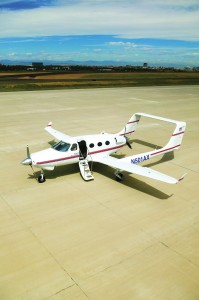
The first customer aircraft of Adam’s A500 series was delivered in November 2005 to Mike Leahy, a Colorado Springs chiropractor.
One of Adam’s major priorities for this year is to increase the production level for the A500 up from its current one a month to three a month. The company will boost production to six a month by early next year and eventually hopes to hit a plateau of around 70 to 80 aircraft per year. It’s getting easier, according to Adam.
“As the team gets more practiced and they learn more shortcuts, we’re getting faster,” he said. “We’re also bringing in more assembly machinery for building tooling that makes it easier to slot them together. Now that we’re much more experienced, we can try different things and there isn’t as much risk anymore.”
The company maintains 20,000 square feet of assembly space at Centennial and two more facilities in Pueblo, Colo., an d Ogden, Utah, all of which will be expanding soon.
To lead those efforts, several new staff members have been hired including COO Craig Johnson, who brings experience from Northrop Grumman and McDonnell Douglas; new vice president of flight operations Bill Watters, formerly chief pilot for Gulfstream; and new vice president of manufacturing Rob Penrod, who helped Bell Helicopter ramp up production on its V-22 Osprey.
“We’re thrilled to have Rob and we were lucky to get him,” Adam said. “He’s just gone through the scale-up on a carbon-fiber aircraft production so he was the perfect guy for us to land for this project.”
As the company starts shifting over from being an engineering company to an aircraft production company, Adam has also begun recruiting the appropriate floor staff. The company has more than 300 employees directly engaged in production who are either composite techs who lay up the aircrafts’ carbon fiber bodies or airframe and powerplant technicians assembling their insides. That number is expected to double within the year.
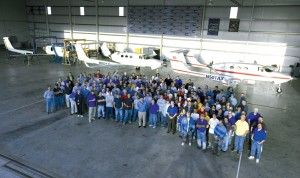
Some of Adam Aircraft’s 300+ assembly facility staff pose in front of the company’s first two prop-driven A500s.
“They’re getting better and better, but we’re also taking up the rate of production so our employee population will definitely be increasing,” Adam said. “All of our facilities are expanding, but we’re out of space here at Centennial so the next expansion of assembly space will be in Utah.”
Racing towards certification
The other priority is getting the FAA certification wrapped up on the A700, although several initial steps have already been completed.
“Between now and the end of the year, the bulk of our work is flight testing to demonstrate that the aircraft works correctly for the FAA,” Adam said. “One of the biggest challenges with the FAA is structural testing—bending, breaking and over pressurizing—and we’ve already done all those tests with the A700.”
In April, the first A700 AdamJet flew to 41,000 feet and achieved a true airspeed of 340 knots, demonstrating the aircraft’s flight capabilities. Earlier this year, serial number 002 entered the flight-test program. That aircraft is painted and striped in air-taxi livery and fully conforms to planned production characteristics. The test flight was crewed by senior test pilot Ken Sasine and copilot Dan Brand, but Adam has paid close attention to the results.
“When they hit 41,000 feet, the A700 was still climbing at 1,500 feet per minute, which is unheard of in a light jet,” he said. “It looks like the airplane has lots of extra power.”
Although he admits that working with the FAA has presented far more challenges than designing or funding his airplanes, Adam says the company’s working partnership with the government has evolved over time.
“Some of our initial struggles were based on our being a new company,” he said. “At this point in time, we have an extremely good relationship. The FAA has a choice about how much they check and how much they delegate to a company, whether it’s Boeing or Cessna or us. More and more, they’re delegating the testing to us and spot checking us much less frequently because they’ve watched us grow up.”

Adam Aircraft has ramped up its production facilities in Colorado and Utah and eventually plans to produce up to 80 A500s per year.
The other advantage Adam has in the A700 is its unique modular structure, much of which is taken directly from the A500’s design. The two aircraft share more than their unique carbon-fiber skins.
“Sixty to 70 percent of the parts are either direct copies or directly derived from the prop plane,” Adam explained. “That makes the job much easier. What we’re really after here is understanding where we have the ability to innovate and balancing that against the laws of aerodynamics, and blending the two together.”
Going to market
Adam’s backlog for the A500 and A700 now totals more than $740 million, with more than 360 aircraft orders on the books, including 70+ orders from owner-operators for the A500 and 60+ orders from owner-operators for the A700. Interest was more than brisk at Sun n’ Fun, where both the A500 and A700 flew demonstration flights.
“We had as much or more traffic than anybody around us,” said Terry Truman, Adam Aircraft’s vice president of marketing. “We took away a lot of interest from qualified owners who fly good airplanes, who are typically good to move up into the A500. It was a great show for us.”
Many of the A500 customers are also interested in the company’s step-up program, which is designed to allow A500 owners to upgrade to the A700 when the AdamJet is ready.
“Deep down inside, everyone who takes flying lessons wants to be a jet pilot someday,” Adam observed. “It turns out that it’s really hard to make the transition from being a piston pilot to being a jet pilot. The catch-22 is that the insurance companies don’t want to insure you until you get turbine time, but you can’t get turbine time until you get insurance.”
To alleviate that problem, Adam has worked with insurance carriers to guarantee insurability in the A700 for pilots who place parallel orders for the A500 and A700, complete the factory training program on the A500 and fly the A500 for a minimum of 200 hours before taking delivery of their AdamJet.
The new jet pilot is guaranteed full coverage for the aircraft and $1 million in liability insurance. Adam Aircraft will also accept the A500 in trade for the Blue Book value or 1.5 percent per month off the A500 purchase price, whichever is higher. The company will also defer $50,000 of the initial A700 deposit requirement until the jet is certified.
“For the first time, this gives a step-up pilot a very clean method to become insurable in a jet,” Adam said. “We have an improved deposit schedule and a guaranteed trade-in allowance for the prop plane so we’ve made it an attractive offer for the guy who wants to fly his own jet plane.”
It’s not an idle offer. The company has done extensive market research to examine and identify customers in their potential step-up market.

Side by side, it’s easy to see the similarities between the A500 (front) and the A700 AdamJet (back), which share up to 70 percent of their parts.
“If you look at the people who are buying the other next-generation, single-engine aircraft like the Cirrus and the Lancair, more than half of those folks are qualified financially to own a very light jet,” Adam explained. “Those are the ones making the journey to becoming a jet pilot and we’re the ideal stepping stone for them to accomplish that goal.”
The A500 also has its own built-in market, based on the fact that there haven’t been many viable replacement candidates for pilots flying aging pressurized aircraft originally built by Piper, Cessna and Beechcraft. Adam points out that the parallel issue for these aging fleets is the current high cost of fuel.
“If gas is 20 dollars a barrel, you can afford to fly an old Westwind or a King Air,” Adam observed. “If fuel is 80 dollars a barrel, you’ll save money by buying our airplane because it’s so much more fuel-efficient. Old airplanes have always been maintenance hogs, but the biggest problem these days is that they’re too expensive to fly. We’re going to get a lot of business simply because guys are looking at their fuel bill and realizing that they can’t afford to fly ‘Old Betsy’ anymore.”
Adam’s fleets
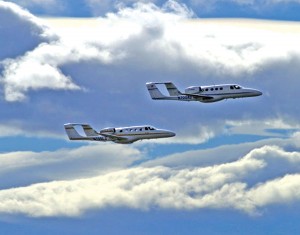
The first two A700 AdamJets are up and flying with the same aerodynamic profile and dimensions, sharing 80 percent parts commonality.
The other significant market driving Adam Aircraft’s sales is the bevy of air-taxi operators who are pining for their aircraft. Adam currently has over 225 orders for fleet aircraft, which represents more than $500 million of the company’s backlog.
Adam has already secured an order for 100 airplanes from a European fractional air cargo operator and another significant order from a U.S. firm operating on a hybrid cargo/air-taxi model. In May, the company spent a week at the European Business Aviation Convention & Exhibition, where they were approached with nearly a dozen solid prospects—all European air taxi services who wanted to start evaluating the jets.
While he’s pleased with the influx of orders, Adams hasn’t built his company based on the fleet market.
“We have a very efficient company and a well-engineered airplane. The result of that is that we can break even with a very low number of planes,” he said. “That’s the case even if we only produce 50 to 70 planes a year, and we’re absolutely sure that this market is here. If we don’t see runaway orders in the fleet markets in the early days, we still become profitable early. Some of our competitors can’t say that.”
Nevertheless, the company is still welcoming those customers with open arms. In fact, the company’s biggest challenge currently is figuring out how to build airplanes fast enough to meet the demands of professional operators.
“I think the likelihood is that VLJs are going to be best-sellers and a lot of them are going to be professionally operated,” Adam predicted. “Whether you call them charter guys or air cargo guys or taxi services, my guess is that two-thirds of the light jets across the board are going to be operated by third parties on behalf of the passenger. I think it’s going to be a significant market, but my point is that we don’t need that market in order to be profitable.”
Going worldwide

A substantial portion of Adam Aircraft’s backlog is driven by fleet sales for the A700, decked out here in air-taxi livery.
Adam believes that the market for VLJs will be more significant overseas than in the U.S.
“If you examine the entire spectrum of the business aircraft market, the United States represents 75 percent of the world market, Europe is about 15 percent, South America is seven percent and Asia is three percent,” Adam observed. “I think the very light jets will be different from those numbers. I think we’ll have a much bigger market in Asia for training and also in Europe, because the distances are smaller. It’s far more likely that we’ll have a bigger market outside the U.S. than within it.”
With that vision in mind, a new partnership with an Asia-based company promises to be a windfall for Adam Aircraft. In February, the company announced a strategic partnership with Singapore Technologies Engineering, Ltd.
Under the partnership, Adam will work with the company’s aerospace arm, ST Aerospace. ST will provide engineering, logistics, maintenance, repairs and overhaul support for both VLJ and twin piston aircraft manufactured by Adam Aircraft.
“Our customers are going to be using their aircraft as mini-airliners,” Adam explained. “They would feel more comfortable if they were being maintained by someone with airline maintenance experience and ST is the world leader in aircraft maintenance. They have huge facilities in the U.S., so that will be our primary relationship with them here.”
The partnership will also have a material impact on Adam’s market penetration overseas by giving the aircraft company access that it might not otherwise be capable of securing on its own.
“ST Aerospace will act as our gateway into Asia,” Adam said. “Here’s an example. One of the greatest aviation opportunities in the world is to train airline pilots. Asia and India are now short some 5,000 airline pilots so they have to first train these pilots from the beginning and those guys have to get some jet time in first. ST Aerospace is making a bid into China to launch a training academy using our jets to train Chinese airline pilots. That’s just one example of how this relationship will help us.”
There’s another potential, tangible benefit for Adam Aircraft as well. The partnership provides ST Aerospace with the option, exercisable within seven years, to invest up to $50 million in the company.
Demonstrated success
The attention focused on Adam Aircraft is coming from a diverse number of sectors including our own government. In June 2004, Vice President Dick Cheney came to speak at the company’s Centennial facilities to praise its operations and hold it up as an example of America’s economic growth.
“We’ve created 520 fun, well-paid, manufacturing jobs,” said Adam matter-of-factly. “All the news says you can’t do manufacturing in the U.S. anymore and we’re doing it, just like Cirrus and Lancair and Eclipse are. We’re proving that if you have a high-tech product, you can create manufacturing companies here and everybody gets behind that idea, including your civic and national leaders. It’s a good thing.”
More recently, General Wesley K. Clark, the retired four-star general who ran unsuccessfully for president in 2004, joined the board of directors of Adam Aircraft in March. Clark is on retainer to Goldman Sachs, one of Adam’s biggest investors and Rick Adam’s former employer, but it turns out that they have more in common than the financial firm.
“Wesley loves airplanes,” Adam said. “He lives in Arkansas, where they don’t have the world’s best scheduled air service, so he can’t wait to get his hands on one of ours. Every time he’s in Arkansas, he’s telling his friends to start up an air-taxi service so those guys can get in and out of there more easily.”
Having demonstrated that Adam Aircraft can capably not only design and create an airplane but also manufacture it, Rick Adam is now looking to the future—and planning on building a third airplane.
“We have a lot of money in our budget for a third product,” he confirmed. “It’s not completely defined yet, but it’s likely going to be a bigger jet. We have early designs on a couple of larger airplanes. We could go smaller or bigger with the expertise that we have, but generally as you go bigger the profit margins are better.”
The company hasn’t released the specifics of their new project yet, but Adam obviously has some firm ideas already.
“It’s just a matter of picking the sweet spot,” Adam said. “If you look at the very light jets, the least expensive aircraft you can buy is the Cessna Citation CJ1 for $4.2 million. We have the same cabin space, same range and same speed in the A700 for $2.2 million. We’re a two-to-one value performer over the old generation of aircraft.”
Logically, the same math applies to Adam’s new project.
“So now, as we go to a bigger jet—pick any jet you want for $6,7,8 million—we’ll build one that has the same cabin space, same speed, same range and better operating economics, at half the price,” he said.
When the company was choosing a site for its additional manufacturing facilities in Utah, some Salt Lake City newspapers erroneously reported that Adam was looking to move its headquarters out of Colorado.
“That was just bad reporting,” Adam said. “I’m never moving and I’m going out of my house here in Colorado feet first. They also reported that we were moving all of our jobs to Utah and that’s simply not true. We’re going to create a lot of jobs in Utah, but we’re going to create a lot of jobs in Colorado, too.”
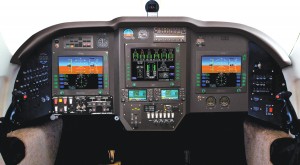
The A700’s avionics suite includes a state-of-the-art glass cockpit that provides all navigational data as well as the capacity to display weather, traffic and terrain data.
Besides, Rick Adam finds that walking into his manufacturing plant every day is one of his greatest joys.
“Every morning when I wake up, I can’t wait to get in here,” he said. “We operate 24 hours a day, so as soon as you walk into the composite shop or here in assembly, something has moved further down the line. It’s great to see the day-to-day process and it’s amazing to see one get finished and take it flying.”
For more information about Adam Aircraft, visit [http://www.adamaircraft.com].













